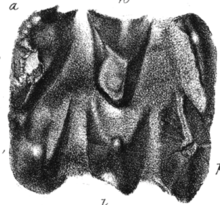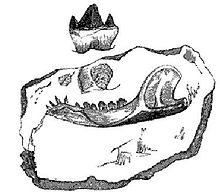

| Taynton Limestone | |
|---|---|
| Stratigraphic range: Bathonian
↓ | |
| Type | Geological formation |
| Unit of | Great Oolite Group |
| Underlies | Hampen Formation, Rutland Formation |
| Overlies | Fuller's Earth Formation, Sharp's Hill Formation, Horsehay Sand Formation |
| Thickness | 0-11 m |
| Lithology | |
| Primary | Limestone |
| Other | Marl, Sandstone |
| Location | |
| Region | Oxfordshire |
| Country | |
| Type section | |
| Named for | Taynton, Oxfordshire |
| Location | Lee's Quarry, Taynton Down, Oxfordshire |
The Taynton Limestone[1] is a geological formationinOxfordshire in the United Kingdom. It dates to the Middle Jurassic, mid-Bathonian stage.[2] It predominantly consists of ooidal grainstone.[3] The term "Stonesfield Slate" refers to slaty limestone horizons within the formation that during the 18th and 19th centuries were extensively quarried for use in roof tiling within the vicinity of Stonesfield, Oxfordshire. Previously these were thought to belong to the Sharp's Hill Formation, but boreholes and shaft sections suggest that at least three horizons within the Taynton Limestone were quarried for the slate.[4] These horizons are well known for producing a diverse set of fossils including those of plants, insects as well as vertebrates, including some of the earliest known mammals, pterosaurs as well as those of first dinosaur ever described, Megalosaurus.
| Reptiles of the Stonesfield Slate[5] | ||||||
|---|---|---|---|---|---|---|
| Taxa | Species | Material | Location | Notes | Images | |
| Iliosuchus | I. incognitus | Two ilia | A theropod dinosaur. Not distingusiable from Megalosaurus | |||
| Megalosaurus | M. bucklandii | Isolated remains including several dentaries, maxillas and postcranial bones from multiple individuals | Amegalosaurid theropod dinosaur, also present in the Chipping Norton and Sharp's Hill Formations |  | ||
| Klobiodon[6] | K. rochei | Partial dentary with teeth | Arhamphorhynchid pterosaur |  | ||
| Protochelys | P. blakii | Isolated epidermal scales, coracoid, plastron fragment[7] | Nomen dubium, Testudinata indet | |||
| Teleosaurus | T. geoffroyi | An indeterminate Teleosaurid. Probably the same animal as Teleosaurus cadomensis. | ||||
| Monofenestrata[6] | Indeterminate | Vertebrae | ||||
| Rhamphorhynchidae[6] | Indeterminate | Various isolated remains | ||||
| Mammaliamorphs of the Stonesfield Slate[5] | ||||||
|---|---|---|---|---|---|---|
| Taxa | Species | Material | Location | Notes | Images | |
| Amphilestes | A. broderipii | Two left mandibles and right mandible | Stonesfield Slate quarries | Amphilestid | ||
| Amphitherium | A. prevostii | Partial left mandible and a right mandible | Amphitheriidae |  | ||
| A. rixoni | Right dentary | |||||
| Stereognathus | S. ooliticus | Teeth | Tritylodontid |  | ||
| Phascolotherium | P. bucklandii | Right mandible and left ramus | Amphilestid |  | ||
| Fish of the Stonesfield Slate[5] | ||||||
|---|---|---|---|---|---|---|
| Taxa | Species | Material | Location | Notes | Images | |
| Breviacanthus | Breviacanthus brevis | Stonesfield Slate quarries | ||||
| Ganodus | Spp. | Chimaeriformes | ||||
| Ischyodus | Ischyodus emarginatus | |||||
| Aspidorhynchus | Aspidorhynchus crassus | |||||
| Pholidophorus | Indeterminate | |||||
| Leptolepis | Leptolepis disjectus | |||||
| Pycnodus | Indeterminate | |||||
| Mesodon | Mesodon tenuidens | |||||
| Microdon | Microdon biserialis | |||||
| Lepidotus | Lepidotus tuberculatus | |||||
| Macrosemius | Macrosemius sp. | |||||
| Undina | Undina ? barroviensis | Acoelacanth | ||||
| Ceratodus | Ceratodus phillipsi | A lungfish | ||||
| Egertonodus[8] | Egertonodus duffini | Ahybodont shark | ||||
| Palaeocarcharias?[9] | Indeterminate | Possibly the oldest lamniform shark | ||||
| Invertebrates of the Stonesfield Slate | ||||||
|---|---|---|---|---|---|---|
| Taxa | Species | Presence | Material | Notes | Images | |
| B. egertoni | Stonesfield Slate | NHM, In. 34379, a ventral compression missing the head | Anommatine beetle |  | ||
| Palaeontina | P. oolitica | Forewing | Type species of Palaeontinidae | |||
| Pheugothemis | P. westwoodi | Damsel-dragonfly of uncertain placement, while historically described as a member of Gomphidae, Huang et al. 2019 state that it "can[not] be accurately attributed to the Gomphidae, or even the Gomphida." | ||||
The flora known from the Stonesfield Slate comprises a relatively diverse flora, with 25 morphospecies present. It primarily represents a coastal environment, perhaps seasonally dry with mangrove like environments. It is a noticeably different assemblage than the Yorkshire floras of equivalent age, possibly because the latter is thought to represent a deltaic, wetland environment.[10]
| Flora of the Stonesfield Slate | ||||||
|---|---|---|---|---|---|---|
| Taxa | Species | Material | Location | Notes | Images | |
| cf. Dictyophyllum | Indeterminate | Fern, Member of Dipteridaceae | ||||
| Phlebopteris | P. woodwardii | Fern, Member of Matoniaceae | ||||
| cf. Coniopteris | Indeterminate | Fern, Member of Dicksoniaceae | ||||
| Sagenopteris | S. colpodes | Member of Caytoniales | ||||
| Ctenozamites | cf. leckenbyi | Member of Peltaspermales | ||||
| Pachypteris | P. macrophylla | A "Pteridosperm", likely either a member of PeltaspermalesorCorystospermales | ||||
| Komlopteris | K. speciosa | Member of Corystospermales | ||||
| Ctenis | C. cf. sulcicaulis, sp | Cycad | ||||
| Ptilophyllum | P. pectiniformis, P. cf hirsutum | Member of Bennettitales | ||||
| Sphenozamites | S. bellii | Member of Bennettitales | ||||
| ?Weltrichia | Indeterminate | Member of Bennettitales | ||||
| Taeniopteris | T. vittata | Member of Bennettitales | ||||
| Bucklandia | B. bucklandii | Member of Bennettitales formerly Conites bucklandii[11] | ||||
| Ginkgo | G. aff longifolius | Member of Ginkgoales | ||||
| Brachyphyllum | B. expansum | Member of Pinales | ||||
| Elatocladus | E. cf. laxus | Member of Pinales | ||||
| Masculostrobus | Indeterminate | Member of Pinales | ||||
| Classostrobus | Indeterminate | Cheirolepidiaceae | ||||
| Araucarites | A. brodei | Araucariaceae | ||||
| Pelourdea | A conifer of uncetain affinities | |||||
| Carpolithes | Carpolithes diospyriformis, Carpolithes sp. | Plantae indet | ||||
| Phyllites | sp. | Morphotaxon for leaves of uncertain affinities | ||||